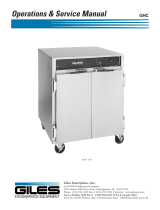
2 GHP12InstallationInstructions
Registering the Device ................................................................ 1
Contacting Garmin Product Support............................................ 1
Important Safety Information ....................................................... 1
Main Components ....................................................................... 3
CCU .................................................................................................. 3
ECU .................................................................................................. 3
GHC 20 ............................................................................................. 3
Shadow Drive ................................................................................... 3
Cables and Connectors ............................................................... 3
CCU/ECU Interconnect Cable .......................................................... 3
Alarm................................................................................................. 4
ECU Power Cable ............................................................................. 4
GHC 20 NMEA 0183 Data Cable ...................................................... 4
NMEA 2000 Cables and Connectors ................................................ 4
Tools Needed............................................................................... 4
Mounting and Connection Considerations................................... 5
Drive Unit Mounting and Wiring Considerations ............................... 5
ECU Mounting and Wiring Considerations ....................................... 5
CCU Mounting Considerations ......................................................... 5
CCU Wiring Considerations .............................................................. 5
Alarm Mounting and Wiring Considerations ..................................... 5
NMEA 2000 Wiring Considerations .................................................. 5
GHC 20 Mounting Considerations .................................................... 5
GHC 20 Wiring Considerations ......................................................... 5
Shadow Drive Mounting Considerations ........................................... 6
General Connections Diagram .................................................... 7
General Component Layout Diagram .......................................... 8
Drive Unit Installation................................................................... 9
Installing a Garmin Drive Unit ........................................................... 9
Preparing a non-Garmin Drive Unit .................................................. 9
Preparing a Solenoid Drive Unit ....................................................... 9
ECU Installation ......................................................................... 10
Mounting the ECU .......................................................................... 10
Connecting the Drive Unit to the ECU ............................................ 10
Connecting the ECU to Power ........................................................ 10
CCU Installation......................................................................... 10
Installing the CCU Mounting Bracket .............................................. 10
Connecting the CCU ........................................................................11
Alarm Installation ........................................................................11
Mounting the Alarm ..........................................................................11
Connecting the Alarm ......................................................................11
GHC 20 Installation ....................................................................11
Mounting the GHC 20 ......................................................................11
Connecting the GHC 20 .................................................................. 12
Multiple GHC 20 Considerations .................................................... 12
Connecting the Devices to a NMEA 2000 Network ................... 12
Building a Basic NMEA 2000 Network for the GHC 20
and the CCU ............................................................................. 13
Connecting Optional Devices to the GHP 12
Autopilot System ..................................................................... 14
Connecting an Optional NMEA 2000-compatible Device
to the GHP 12............................................................................ 14
NMEA 0183 Connection Considerations ........................................ 14
Connecting an Optional NMEA 0183-compatible Device to the
GHC 20 ..................................................................................... 14
Shadow Drive Installation .......................................................... 14
Connecting the Shadow Drive to the Hydraulics ............................ 14
Connecting the Shadow Drive ........................................................ 14
Dockside Wizard........................................................................ 15
Performing the Dockside Wizard ............................................... 15
Starting the Dockside Wizard ......................................................... 15
Selecting the Drive Unit Class ........................................................ 15
Selecting the Drive Unit Voltage ..................................................... 15
Selecting the Clutch Voltage ........................................................... 15
Selecting the Solenoid Voltage ....................................................... 15
Selecting the Bypass Valve Voltage................................................ 15
Enabling Shadow Drive .................................................................. 15
Calibrating the Rudder .................................................................... 15
Tuning a Non-Garmin Drive Unit ..................................................... 16
Testing the Steering Direction ......................................................... 16
Selecting the Speed Source ........................................................... 16
Verifying the Tachometer ................................................................ 16
Reviewing the Results of the Dockside Wizard .............................. 16
Sea Trial Wizard ........................................................................ 17
Important Sea Trial Wizard Considerations ............................... 17
Performing the Sea Trial Wizard................................................ 17
Starting the Sea Trial Wizard .......................................................... 17
Conguring the Planing RPM ......................................................... 17
Conguring the Planing Speed ....................................................... 17
Conguring the High RPM Limit ..................................................... 17
Conguring the Maximum Speed ................................................... 17
Calibrating the Compass ................................................................ 17
Performing the Autotune Procedure ............................................... 17
Setting North ................................................................................... 18
Evaluating the Results of the Autopilot Conguration................ 18
Testing and Adjusting the Autopilot Conguration ........................... 18
Reducing the Risk of ECU Drive Circuit Overload .......................... 19
Adjusting the Rudder Rate Limiter .................................................. 19
Advanced Conguration ............................................................ 19
Enabling Dealer Autopilot Conguration ......................................... 19
Advanced Conguration Settings ................................................... 19
Manually Running the Automated Conguration Procedures ......... 19
Manually Dening Individual Conguration Settings ....................... 19
Manually Adjusting the Settings for a Non-Garmin Drive Unit ........ 20
Performing Advanced Tuning Procedures for Non-Garmin
Drive Units ................................................................................. 20
NMEA 0183 Wiring Diagrams .................................................... 21
Specications ............................................................................ 23
NMEA 2000 PGN Information.................................................... 23
CCU ................................................................................................ 23
GHC 20 ........................................................................................... 23
NMEA 0183 Information ............................................................ 24
GHP 12 Conguration Settings ................................................. 25
Error and Warning Messages .................................................... 27
Mounting Templates .................................................................. 29
ECU Mounting Template ................................................................. 29
CCU Mounting Template ................................................................. 29
GHP 12 Installation Checklist .................................................... 31




















